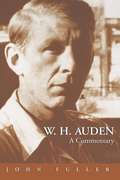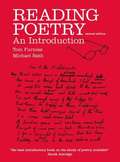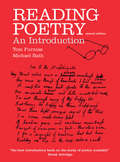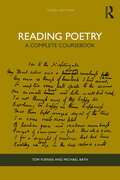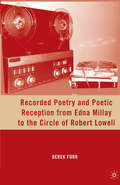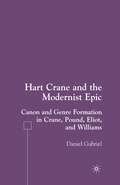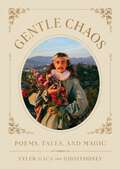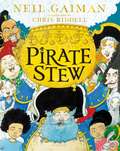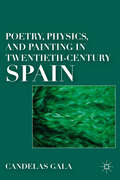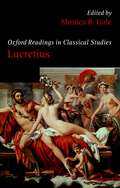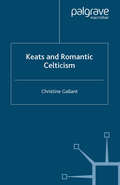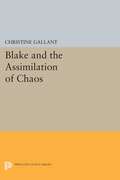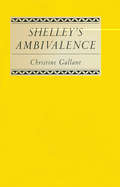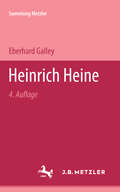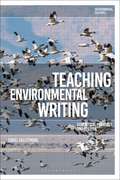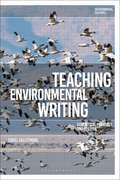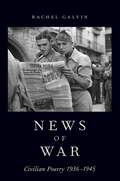- Table View
- List View
W. H. Auden: A Commentary
by John FullerThis is an indispensable reference guide to the works of one of the most important poets of the twentieth century. W. H. Auden's writing is notoriously complex--full of puzzling allusions and shaped by influences as diverse as Old English poetry and Auden's own theory of psychosomatic illness. To help readers understand Auden's work, the poet and scholar John Fuller examines all of Auden's published poems, plays, and libretti, leaving out only some juvenilia. In unprecedented detail, he reviews the works' publishing history, paraphrases difficult passages, and explains allusions. He points out interesting variants (including material abandoned in drafts), identifies sources, looks at verse forms, and offers critical interpretations. Along the way, he presents a wealth of facts about Auden's works and life that are available in no other publication. The book is a major revision of Fuller's critically acclaimed Reader's Guide to Auden, published in 1970. It contains more than twice the material of that earlier volume. Fuller organizes the book on the basis of the individual collections that Auden himself originally published, with sections of "uncollected" work interwoven. Clear, meticulously researched, and carefully designed for ease of use, it is an essential guide for anyone interested in Auden's remarkable and sometimes elusive writing.
Who Is Ozymandias?: And other Puzzles in Poetry
by John FullerPart of the pleasure of poetry is unravelling the mysteries and difficulties it contains and solving the puzzles that lie within. Who, for instance, is Ozymandias? What is the Snark? Who is the Emperor of Ice-Cream? Or indeed, who is 'you' in a poem? In this perceptive and playful new book, acclaimed poet John Fuller looks at some of our greatest poems and considers the number of individual puzzles at their heart, casting light on how we should approach these conundrums as readers. From riddling to double entendres, mysterious titles to red herrings, Fuller unpicks the puzzles in works that range from Browning to Bishop, Empson to Eliot, Shelley to Stevens, to help us reach the rewards and revelations that lie at the centre of some of our best-loved poems.
Reading Poetry: An Introduction (PDF)
by Tom Furniss Michael BathReading Poetry offers a comprehensive and accessible guide to the art of reading poetry. Successive chapters introduce key skills and critical or theoretical issues, enabling users to read poetry with enjoyment, insight and an awareness of the implications of what they are doing. This new edition includes a new chapter on 'Post-colonial Poetry', a substantial increase in the number of end-of-chapter interactive exercises, and a comprehensive Glossary of poetic terms. Not just an add-on, the Glossary works as a key resource for the structuring of particular topics in any individual teaching or learning programme. Many of the exercises and interactive discussions develop not only the skills of competent close reading but also the necessary confidence and experience in locating historical and other contextual information through library or internet searches. The aim is to enhance readers' literary and scholarly competence - and to make it fun!
Reading Poetry: An Introduction
by Tom Furniss Michael BathReading Poetry offers a comprehensive and accessible guide to the art of reading poetry. Successive chapters introduce key skills and critical or theoretical issues, enabling users to read poetry with enjoyment, insight and an awareness of the implications of what they are doing. This new edition includes a new chapter on 'Post-colonial Poetry', a substantial increase in the number of end-of-chapter interactive exercises, and a comprehensive Glossary of poetic terms. Not just an add-on, the Glossary works as a key resource for the structuring of particular topics in any individual teaching or learning programme. Many of the exercises and interactive discussions develop not only the skills of competent close reading but also the necessary confidence and experience in locating historical and other contextual information through library or internet searches. The aim is to enhance readers' literary and scholarly competence - and to make it fun!
Reading Poetry: An Introduction
by Tom Furniss Michael BathReading Poetry offers a comprehensive and accessible guide to the art of reading poetry. Successive chapters introduce key skills and critical or theoretical issues, enabling users to read poetry with enjoyment, insight and an awareness of the implications of what they are doing. This new edition includes a new chapter on ‘Post-colonial Poetry’, a substantial increase in the number of end-of-chapter interactive exercises, and a comprehensive Glossary of poetic terms. Not just an add-on, the Glossary works as a key resource for the structuring of particular topics in any individual teaching or learning programme. Many of the exercises and interactive discussions develop not only the skills of competent close reading but also the necessary confidence and experience in locating historical and other contextual information through library or internet searches. The aim is to enhance readers' literary and scholarly competence – and to make it fun!
Reading Poetry: An Introduction
by Tom Furniss Michael BathReading Poetry offers a comprehensive and accessible guide to the art of reading poetry. Successive chapters introduce key skills and critical or theoretical issues, enabling users to read poetry with enjoyment, insight and an awareness of the implications of what they are doing. This new edition includes a new chapter on ‘Post-colonial Poetry’, a substantial increase in the number of end-of-chapter interactive exercises, and a comprehensive Glossary of poetic terms. Not just an add-on, the Glossary works as a key resource for the structuring of particular topics in any individual teaching or learning programme. Many of the exercises and interactive discussions develop not only the skills of competent close reading but also the necessary confidence and experience in locating historical and other contextual information through library or internet searches. The aim is to enhance readers' literary and scholarly competence – and to make it fun!
Reading Poetry: A Complete Coursebook
by Tom Furniss Michael BathReading Poetry offers a comprehensive and accessible guide to the art of reading poetry. Discussing more than 200 poems by more than 100 writers, ranging from ancient Greece and China to the twenty-first century, the book introduces readers to the skills and the critical and theoretical awareness that enable them to read poetry with enjoyment and insight. This third edition has been significantly updated in response to current developments in poetry and poetic criticism, and includes many new examples and exercises, new chapters on ‘world poetry’ and ‘eco-poetry’, and a greater emphasis throughout on American poetry, including the impact traditional Chinese poetry has had on modern American poetry. The seventeen carefully staged chapters constitute a complete apprenticeship in reading poetry, leading readers from specific features of form and figurative language to larger concerns with genre, intertextuality, Caribbean poetry, world poetry, and the role poetry can play in response to the ecological crisis. The workshop exercises at the end of each chapter, together with an extensive glossary of poetic and critical terms, and the number and range of poems analysed and discussed – 122 of which are quoted in full – make Reading Poetry suitable for individual study or as a comprehensive, self-contained textbook for university and college classes.
Reading Poetry: A Complete Coursebook
by Tom Furniss Michael BathReading Poetry offers a comprehensive and accessible guide to the art of reading poetry. Discussing more than 200 poems by more than 100 writers, ranging from ancient Greece and China to the twenty-first century, the book introduces readers to the skills and the critical and theoretical awareness that enable them to read poetry with enjoyment and insight. This third edition has been significantly updated in response to current developments in poetry and poetic criticism, and includes many new examples and exercises, new chapters on ‘world poetry’ and ‘eco-poetry’, and a greater emphasis throughout on American poetry, including the impact traditional Chinese poetry has had on modern American poetry. The seventeen carefully staged chapters constitute a complete apprenticeship in reading poetry, leading readers from specific features of form and figurative language to larger concerns with genre, intertextuality, Caribbean poetry, world poetry, and the role poetry can play in response to the ecological crisis. The workshop exercises at the end of each chapter, together with an extensive glossary of poetic and critical terms, and the number and range of poems analysed and discussed – 122 of which are quoted in full – make Reading Poetry suitable for individual study or as a comprehensive, self-contained textbook for university and college classes.
Recorded Poetry and Poetic Reception from Edna Millay to the Circle of Robert Lowell
by D. FurrThrough an analysis of a wide range of commercial and amateur recordings, this book describes how and why poetry was recorded in the U.S., from the 1930's through the mid-century performances of poets such as Dylan Thomas and Anne Sexton.
Selected Poems of Solomon Ibn Gabirol
by Solomon Ibn Gabirol Peter ColePoet, philosopher, and sensitive misanthrope, a spectacular fly in the ointment of the refined eleventh-century Andalusian-Jewish elite, Solomon Ibn Gabirol comes down to us as one of the most complicated intellectual figures in the history of post-biblical Judaism. Unlike his worldly predecessor Shmuel HaNagid, the first important poet of the period, Ibn Gabirol was a reclusive, mystically inclined figure whose modern-sounding medieval poems range from sublime descriptions of the heavenly spheres to poisonous jabs at court life and its pretenders. His verse, which demonstrates complete mastery of the classicizing avant-garde poetics of the day, grafted an Arabic aesthetic onto a biblical vocabulary and Jewish setting, taking Hebrew poetry to a level of metaphysical sophistication and devotional power it has not achieved since. Peter Cole's selection includes poems from nearly all of Ibn Gabirol's secular and liturgical lyric genres, as well as a complete translation of the poet's long masterwork, "Kingdom's Crown." Cole's rich, inventive introduction places the poetry in historical context and charts its influence through the centuries. Extensive annotations accompany the poems. This companion volume to Peter Cole's critically acclaimed Selected Poems of Shmuel HaNagid presents the first comprehensive selection of Ibn Gabirol's verse to be published in English and brings to life an astonishing body of poetry by one of the greatest Jewish writers of all time.
Hart Crane and the Modernist Epic: Canon and Genre Formation in Crane, Pound, Eliot, and Williams
by D. GabrielThis study examines Hart Crane's canonical ambitions in The Bridge and argues for a new species of epic, 'the modernist epic,' which also includes Pound's The Cantos, Eliot's The Waste Land, and Williams's Paterson. It offers a close reading of The Bridge as a hybrid of lyric and epic modes. Crane's sublime and history converge in a complex synthesis of form and ideas. The study reconceives Crane's achievement by locating him in an intertextual system of production while also recognizing his poetic making of self. Yet in this work Crane assumes a greater political presence than much commentary has entertained.
Open-Air Shakespeare: Under Australian Skies (Global Shakespeares)
by R. GabyMany people today first encounter staged Shakespeare in an open-air setting. This book traces the history of open-air Shakespeares in Australia to investigate why the anomaly of adapting 400-year old plays under Australian skies exerts such a strong appeal.
Gentle Chaos: Poems, Tales, and Magic
by Tyler GacaFrom the wild imagination of Tyler Gaca, also known as TikTok's Ghosthoney, comes a beautiful compendium of poems, images, personal stories, and vignettes that explore magic, queerness, Tyler&’s unique story, and the enchantment and comfort to be found in the weird, the dark, and the different. In this raw yet enchanting collection of poems, essays, photographs, and artworks, Tyler Gaca dreamily navigates themes of magic and queerness, offering readers an intimate look inside his mind and his worlds, real and imagined. The writings in Gentle Chaos reflect on growing up queer and in love with magic, discovering yourself and your place in the world, and daring to seek out love and hope. The artworks are dedicated to salvaged antique photographs, haircuts, dead moths, the creatures we dream up, and much more. The result is a whimsical, vulnerable, and transporting journey into the gentle chaos within us all.
Pirate Stew: The show-stopping new picture book from Neil Gaiman and Chris Riddell
by Neil GaimanMeet LONG JOHN McRON, SHIP'S COOK . . . and the most unusual babysitter you've ever seen.Long John has a whole crew of wild pirates in tow, and – for two intrepid children – he's about to transform a perfectly ordinary evening into a riotous adventure beneath a pirate moon. It's time to make some PIRATE STEW.Pirate Stew! Pirate Stew!Pirate Stew for me and you!Pirate Stew, Pirate StewEat it and you won't be blueYou can be a pirate too!Marvellously silly and gloriously entertaining, this tale of pirates, flying ships, donut feasts and some rather magical stew is perfect for all pirates, both young and old. With a deliciously rhyming text from master storyteller Neil Gaiman, and spellbinding illustrations by the supremely talented Chris Riddell, three-times-winner of the Kate Greenaway Medal, this is the picture book of the year! Joyful, quirky and action-packed, it makes a spectacular and magical gift.
What You Need to Be Warm
by Neil GaimanSometimes it only takes a stranger in a dark place... to say we have the right to be here, to make us warm in the coldest season. In 2019, Neil Gaiman asked his Twitter followers: What reminds you of warmth? Over 1,000 responses later, Neil began to weave replies from across the world into a poem in aid of the UNHCR's winter appeal. It revealed our shared desire to feel safe, welcome and warm in a world that can often feel frightening and lonely.Now publishing in hardback and illustrated by a group of artists from around the world, What You Need to Be Warm is an exploration of displacement and flight from conflict through the objects and memories that represent warmth. It is about our right to feel safe, whoever we are and wherever we are from. It is about holding out a hand to welcome those who find themselves far from home. Featuring new, original illustrations from Chris Riddell, Benji Davies, Yuliya Gwilym, Nadine Kaadan, Daniel Egnéus, Pam Smy, Petr Horácek, Beth Suzanna, Bagram Ibatoulline, Marie-Alice Harel, Majid Adin and Richard Jones, with a thought-provoking cover from Oliver Jeffers.Sales of every copy of this book will help support the work of UNHCR, the UN Refugee Agency, which helps forcibly displaced communities and stateless people across the world.
Poetry, Physics, and Painting in Twentieth-Century Spain
by C. GalaThis book reads the work of Salinas, Guillén, Larrea, Diego, Alberti, Méndez, and Lorca in analogical relation with Cubism and with the revolutionary discoveries of modern physics. Gala advances traditional criticism by considering these artists in the broader cultural context of Spain, Europe, and European Modernism.
Oxford Readings In Lucretius (Oxford Readings In Classical Studies)
by Monica R. GaleThis book gathers together some of the most important and influential scholarly articles of the last sixty to seventy years (three of which are translated into English here for the first time) on the Roman poet Lucretius. Lucretius' philosophical epic, the De Rerum Natura or On the Nature of the Universe (c.55 BC), seeks to convince its reader of the validity of the rationalist theories of the Hellenistic thinker Epicurus. The articles collected in this volume explore Lucretius' poetic and argumentative technique from a variety of perspectives, and also consider the poem in relation to its philosophical and literary milieux, and to the values and ideology of contemporary Roman society. All quotations in Latin or Greek are translated.
Keats and Romantic Celticism
by C. GallantThe Celtic Revival began more than a century before Yeats and the Irish Literary Renaissance. Keats and Romantic Celtism is the first book to consider the pervasive influence of period Celticism upon Keats's work, from the Druidism that underlies his unfinished epics to the Celtic-derived folklore that his poetry draws upon. Christine Gallant shows that more than two hundred and fifty traditional folklore motifs of the faerie fill his major poems, as well as minor epistolary ones that have been critically neglected.
Blake and the Assimilation of Chaos
by Christine GallantIn all of his works Blake struggled with the question of how chaos can be assimilated into imaginative order. Blake's own answer changed in the course of his poetic career. Christine Gallant contends that during the ten year period of composition of Blake's first comprehensive epic, The Four Zoas, Blake's myth expanded from a closed, static system to an open, dynamic process. She further argues that it is only through attention to the changing pattern of Jungian archetypes in the poem that one can discern this profound change. Using the depth psychology of Jung, Professor Gallant presents a comprehensive interpretation of Blake's poetry from his early "Lambeth" prophecies to his mature works, The Four Zoas, Milton, and Jerusalem. She offers a Jungian critical approach that respects the work's autonomy, but still suggests how literature is an ongoing imaginative experience in which archetypal symbols affect their literary contexts. What interests the author is the function that the very process of mythmaking had for Blake. Professor Gallant finds that the metaphysical opposition between God and Satan in Blake's earlier work gradually evolves into an interplay of these powers in the later works. The quality of Chaos changes for Blake from something unknown and feared, contrary to Order, to something intimately known and embraced.Originally published in 1979.The Princeton Legacy Library uses the latest print-on-demand technology to again make available previously out-of-print books from the distinguished backlist of Princeton University Press. These editions preserve the original texts of these important books while presenting them in durable paperback and hardcover editions. The goal of the Princeton Legacy Library is to vastly increase access to the rich scholarly heritage found in the thousands of books published by Princeton University Press since its founding in 1905.
Shelley's Ambivalence (Studies in Romanticism)
by Christine GallantA study of Shelley's poetry, approaching it from the viewpoint of contemporary Jungian analytical psychology that incorporates the theories of Melanie Klein and D.W. Winnicott. Material that relates to the earliest stages of the ego's development - to the pre-Oedipal situation - are used.
Teaching Environmental Writing: Ecocritical Pedagogy and Poetics (Environmental Cultures)
by Isabel GalleymoreEnvironmental writing is an increasingly popular literary genre, and a multifaceted genre at that. Recently dominated by works of 'new nature writing', environmental writing includes works of poetry and fiction about the world around us. In the last two decades, universities have begun to offer environmental writing modules and courses with the intention of teaching students skills in the field of writing inspired by the natural world. This book asks how students are being guided into writing about environments. Informed by independently conducted interviews with educators, and a review of existing pedagogical guides, it explores recurring instructions given to students for writing about the environment and compares these pedagogical approaches to the current theory and practice of ecocriticism by scholars such as Ursula Heise and Timothy Morton. Proposing a set of original pedagogical exercises influenced by ecocriticism, the book draws on a number of self-reflexive, environmentally-conscious poets, including Juliana Spahr, Jorie Graham and Les Murray, as creative and stimulating models for teachers and students.
Teaching Environmental Writing: Ecocritical Pedagogy and Poetics (Environmental Cultures)
by Isabel GalleymoreEnvironmental writing is an increasingly popular literary genre, and a multifaceted genre at that. Recently dominated by works of 'new nature writing', environmental writing includes works of poetry and fiction about the world around us. In the last two decades, universities have begun to offer environmental writing modules and courses with the intention of teaching students skills in the field of writing inspired by the natural world. This book asks how students are being guided into writing about environments. Informed by independently conducted interviews with educators, and a review of existing pedagogical guides, it explores recurring instructions given to students for writing about the environment and compares these pedagogical approaches to the current theory and practice of ecocriticism by scholars such as Ursula Heise and Timothy Morton. Proposing a set of original pedagogical exercises influenced by ecocriticism, the book draws on a number of self-reflexive, environmentally-conscious poets, including Juliana Spahr, Jorie Graham and Les Murray, as creative and stimulating models for teachers and students.
No Worries If Not: A Funny(ish) Story of Growing Up Working Class and Queer
by Soph GalustianNo Worries If Not is a funny, relatable coming-of-age story, that explores Soph Galustian's experiences of poverty, queerness, mental health, grief and community. She recounts her life from childhood, to teens, into adulthood through a mixture of short stories, spoken word, illustrations, and space for the reader to reflect (or draw tits... whatever you prefer).This book is for anyone who was raised struggling, anyone who wrestled with coming out, who accidentally killed their childhood pet, who has lost the person closest to them...Filled with flashbacks to the 2000s/2010s, No Worries If Not is equally for the straights and the gays, the rich and disadvantaged. In this book Soph offers a space to reminisce and laugh at life's misfortunes.A comedy writing star of the future, Soph Galustian's debut book No Worries if Not is a must read!
News of War: Civilian Poetry 1936-1945
by Rachel GalvinNews of War: Civilian Poetry 1936-1945 is a powerful account of how civilian poets confront the urgent problem of writing about war. The six poets Rachel Galvin discusses-W. H. Auden, Marianne Moore, Raymond Queneau, Gertrude Stein, Wallace Stevens, and César Vallejo-all wrote memorably about war, but still they felt they did not have authority to write about what they had not experienced firsthand. Consequently, these writers developed a wartime poetics engaging with both classical rhetoric and the daily news in texts that encourage readers to take critical distance from war culture. News of War is the first book to address the complex relationship between poetry and journalism. In two chapters on civilian literatures of the Spanish Civil War, five chapters on World War II, and an epilogue on contemporary poetry about the wars in Iraq and Afghanistan, Galvin combines analysis of poetic form with attention to socio-historical context, drawing on rare archival sources and furnishing new translations. In comparing how poets wrestled with the limits of bodily experience, and with the ethical, political, and aesthetic problems they faced, Galvin theorizes the concept of meta-rhetoric, a type of ethical self-interference. She argues that civilian writers employed strategies drawn from journalism precisely to question the objectivity and facticity of war reporting. Civilian poetics of the 1930s and 1940s was born from writers' desire to acknowledge their own socio-historical position and to write poems that responded ethically to the gravest events of their day.
